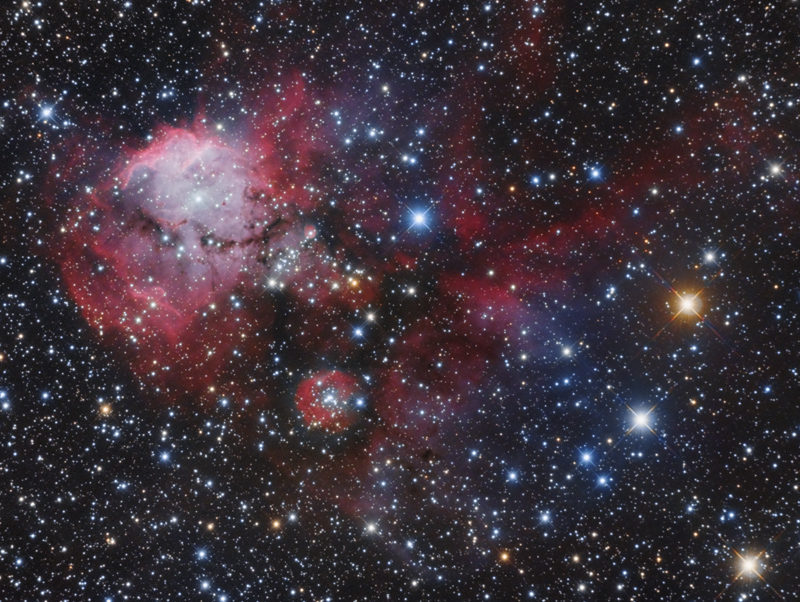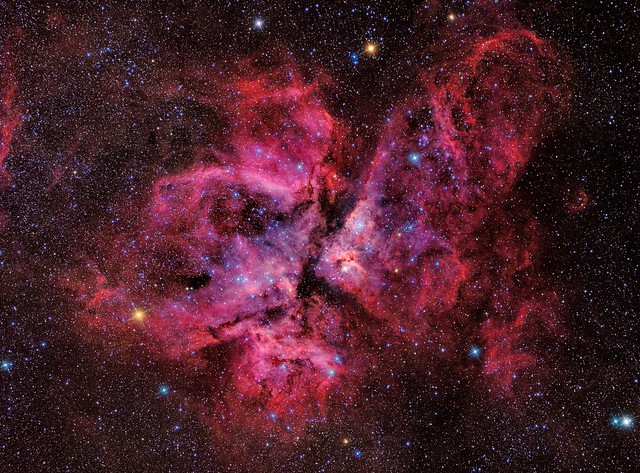Submissions: 2015 January
Re: Submissions: 2015 January
Snow comet over Yunnan
Copyrights: :Zhou Zhen Widefield image of Lovejoy
Copyrights: Hermann Koberger Moon, Mars & Venus
Copyrights: Jack Fusco Venus-moon-Mercury
Copyrights: Richard Mentock NGC6960 and Pickering's Triangle
Copyrights: Ron Brecher Comet Lovejoy on 24th Jan 2015
Copyrights: Ian Sharp
Larger size: http://astro-sharp.com/images/comets/C2 ... 24_ids.jpg Storm, Orion and Canis Major
Copyrights: Davi Weigert
Copyrights: :Zhou Zhen Widefield image of Lovejoy
Copyrights: Hermann Koberger Moon, Mars & Venus
Copyrights: Jack Fusco Venus-moon-Mercury
Copyrights: Richard Mentock NGC6960 and Pickering's Triangle
Copyrights: Ron Brecher Comet Lovejoy on 24th Jan 2015
Copyrights: Ian Sharp
Larger size: http://astro-sharp.com/images/comets/C2 ... 24_ids.jpg Storm, Orion and Canis Major
Copyrights: Davi Weigert
-
PepeChambo
- Ensign
- Posts: 38
- Joined: Thu Mar 28, 2013 8:19 am
- Location: Vallés, Valencia (Spain)
- Contact:
Re: Submissions: 2015 January
Title:
Comet Lovejoy and Pleiades
Object/Date:
C/2014 Q2 (Lovejoy) @ 2015-Jan-17
Description:
Comet C/2014 Q2 (Lovejoy) on January 17, 2015 approaching to 8 deg. from Pleiades star cluster (M 45). Still shining at its maximun around 4th magnitude, its ionic tail with more than 11 deg. long extends beyond the field limits of this image.
Location:
Los Giles - Olba, Teruel (Spain)
Tech data:
Canon lens at 95mm. f/5.6 + Canon EOS 100D camera (4×300 sec. at ISO 1600)
Post link:
http://cometografia.es/lovejoy-pleyades/
Author:
José J. Chambó
Comet Lovejoy and Pleiades
Object/Date:
C/2014 Q2 (Lovejoy) @ 2015-Jan-17
Description:
Comet C/2014 Q2 (Lovejoy) on January 17, 2015 approaching to 8 deg. from Pleiades star cluster (M 45). Still shining at its maximun around 4th magnitude, its ionic tail with more than 11 deg. long extends beyond the field limits of this image.
Location:
Los Giles - Olba, Teruel (Spain)
Tech data:
Canon lens at 95mm. f/5.6 + Canon EOS 100D camera (4×300 sec. at ISO 1600)
Post link:
http://cometografia.es/lovejoy-pleyades/
Author:
José J. Chambó
Re: Submissions: 2015 January
NGC1499
Copyrights: Stephen F. Armen
Full size: https://500px.com/photo/96649785/ngc149 ... er_library Asteroid 2004 BL86
Copyrights: Dieter Willasch
Larger size: http://astro-cabinet.com/showimage.php? ... ng=english Night skies over Mauna Kea
Copyrights: Jacob Gerritsen Meteor and Satellite Crossing
Copyrights: Jeff Dai Mosaic NGC 7000 - IC 5067
Copyrights: César Blanco González
Full size: http://www.cieloprofundo.com/cesar/foto ... GRANDE.jpg Gigantic ring system around J1407b much larger, heavier than Saturn’s
Image credits: Ron Miller
An article: http://www.rochester.edu/newscenter/gig ... nd-j1407b/ http://asterisk.apod.com/viewtopic.php?t=34392
Tarantula nebula
Image Credit & Copyright: Color (RGB+Ha): Aldo Mottino & Ezequiel
Bellocchio (Argentina); Luminance: ESO/J. Emerson/VISTA. NASA, ESA, ESO,
D. Lennon (ESA/STScI) et al., and the Hubble Heritage Team (STScI/AURA). Larger size: http://www.astropilar.com.ar/nebulosas/NGC2070_2.html Night sky and volcano
Copyrights: Tunç Tezel 37 Cluster
Copyrights: Gordon Barrett
Copyrights: Stephen F. Armen
Full size: https://500px.com/photo/96649785/ngc149 ... er_library Asteroid 2004 BL86
Copyrights: Dieter Willasch
Larger size: http://astro-cabinet.com/showimage.php? ... ng=english Night skies over Mauna Kea
Copyrights: Jacob Gerritsen Meteor and Satellite Crossing
Copyrights: Jeff Dai Mosaic NGC 7000 - IC 5067
Copyrights: César Blanco González
Full size: http://www.cieloprofundo.com/cesar/foto ... GRANDE.jpg Gigantic ring system around J1407b much larger, heavier than Saturn’s
Image credits: Ron Miller
An article: http://www.rochester.edu/newscenter/gig ... nd-j1407b/ http://asterisk.apod.com/viewtopic.php?t=34392
Tarantula nebula
Image Credit & Copyright: Color (RGB+Ha): Aldo Mottino & Ezequiel
Bellocchio (Argentina); Luminance: ESO/J. Emerson/VISTA. NASA, ESA, ESO,
D. Lennon (ESA/STScI) et al., and the Hubble Heritage Team (STScI/AURA). Larger size: http://www.astropilar.com.ar/nebulosas/NGC2070_2.html Night sky and volcano
Copyrights: Tunç Tezel 37 Cluster
Copyrights: Gordon Barrett
- felopaul
- Ensign
- Posts: 97
- Joined: Mon Apr 29, 2013 7:14 pm
- AKA: Felopaul
- Location: Flagey (France)
- Contact:
Re: Submissions: 2015 January
IC410 SHO
full size : http://www.cielboreal.com/galerie/photo51f.jpg
http://www.cielboreal.com
Copyright: Jean-Claude CANONNE, Philippe BERNHARD, Didier CHAPLAIN & Laurent BOURGON
full size : http://www.cielboreal.com/galerie/photo51f.jpg
http://www.cielboreal.com
Copyright: Jean-Claude CANONNE, Philippe BERNHARD, Didier CHAPLAIN & Laurent BOURGON
-
terry.hancock
- Ensign
- Posts: 97
- Joined: Sat Jul 17, 2010 4:38 am
The Orion Nebula
Copyright: Andy D'Arienzo & Terry Hancock
One of my earliest collaborations from 2010 with Andy who did the post processing
https://www.flickr.com/photos/terryhanc ... /lightbox/
One of my earliest collaborations from 2010 with Andy who did the post processing
https://www.flickr.com/photos/terryhanc ... /lightbox/
-
astrofotografen.se
- Ensign
- Posts: 34
- Joined: Thu Apr 11, 2013 6:45 am
Re: Submissions: 2015 January
The hidden city of Östersund
http://www.astrofotografen.se
Copyright: Göran Strand Last night there were a very thick fog covering the city of Östersund. In this photo you can see the fog lit up from beneath by the city lights. It's very interesting to see all the different colors from different type of light sources. One of the most known landmarks of Östersund is Rådhuset (City hall) and you can see the tower/spire of that building sticking up through the fog in center of the photo.
http://www.astrofotografen.se
Copyright: Göran Strand Last night there were a very thick fog covering the city of Östersund. In this photo you can see the fog lit up from beneath by the city lights. It's very interesting to see all the different colors from different type of light sources. One of the most known landmarks of Östersund is Rådhuset (City hall) and you can see the tower/spire of that building sticking up through the fog in center of the photo.
Professional photographer Göran Strand, Sweden
http://www.astrofotografen.se
https://www.instagram.com/Astrofotografen
https://twitter.com/Astrofotografen
https://www.facebook.com/fotografgoranstrand
http://www.astrofotografen.se
https://www.instagram.com/Astrofotografen
https://twitter.com/Astrofotografen
https://www.facebook.com/fotografgoranstrand
-
Guest
Re: Submissions: 2015 January
Asteroid 2004 BL86 Passes the Beehive - Timelapse
On January 26 & 27th Asteroid 2004 BL86 passed within 745,000 miles of the Earth. That is about 3 times the distance to the Moon. Traveling at 35,000 miles per hour the Asteroid flew in front of the Beehive Cluster, Messier 44 (M44). During the event I took 607 images of the pass. Due to clouds only 314 were usable. I created a video using these to show 78.5 mins of the Asteroid pass.
On January 26 & 27th Asteroid 2004 BL86 passed within 745,000 miles of the Earth. That is about 3 times the distance to the Moon. Traveling at 35,000 miles per hour the Asteroid flew in front of the Beehive Cluster, Messier 44 (M44). During the event I took 607 images of the pass. Due to clouds only 314 were usable. I created a video using these to show 78.5 mins of the Asteroid pass.
Click to play embedded YouTube video.
Re: Submissions: 2015 January
LBN 406
A very faint Molecular Cloud in Draco
Copyright: Thomas Henne
http://www.distant-lights.at/lbn406-2014_05_20.htm
A very faint Molecular Cloud in Draco
Copyright: Thomas Henne
http://www.distant-lights.at/lbn406-2014_05_20.htm
Re: Submissions: 2015 January
More data added last night to NGC 2175 on a good clear night , Hubble Palette here
https://www.flickr.com/photos/shaun_rey/16383834985/
https://www.flickr.com/photos/shaun_rey/16383834985/
Re: Submissions: 2015 January
Nice work!Guest wrote:Asteroid 2004 BL86 Passes the Beehive - Timelapse
On January 26 & 27th Asteroid 2004 BL86 passed within 745,000 miles of the Earth. That is about 3 times the distance to the Moon. Traveling at 35,000 miles per hour the Asteroid flew in front of the Beehive Cluster, Messier 44 (M44). During the event I took 607 images of the pass. Due to clouds only 314 were usable. I created a video using these to show 78.5 mins of the Asteroid pass.
Re: Submissions: 2015 January
NGC 2467 in Puppis
http://www.astropilar.com.ar/nebulosas/NGC2467_1.html
Copyright: Ezequiel Bellocchio Regards,
Ezequiel.
http://www.astropilar.com.ar/nebulosas/NGC2467_1.html
Copyright: Ezequiel Bellocchio Regards,
Ezequiel.
Re: Submissions: 2015 January
thanksAnn wrote: Rothkko, those are fantastic sundogs!
-
jldauvergne
- Ensign
- Posts: 88
- Joined: Wed Aug 25, 2010 9:11 am
Re: Submissions: 2015 January
2015 is the last year to have good chances to see northern lights
http://astrophotography.fr/
http://www.firstlight-magazine.com/
Copyright: Jean-Luc Dauvergne
I've also done some time lapses :
[youtube]https://www.youtube.com/watch?v=27i0JRs ... e=youtu.be[/youtube]
December 26th, 2014. It was the first day of a trip in Iceland. Just few hours after landing I've seen the best nothern light of the week. This very impressive mountain is Kirkjufell, it means "mountain-church". I was very lucky to shot the aurora just as it took the same shape as the mountain ! Few seconds before or after it was not the same.
I took this image with the new Sony Alpha 7s that is realy very sensitive : its has a big sensor with only 12 millions pixels, and the readout noise is very low.
2015 is the last year to have a solar activity at its best : http://services.swpc.noaa.gov/images/so ... number.gif
May be that the begining of 2016 will allso be ok.
After we will have to wait 2021 or 2022 to have a good level of solar activity.
http://astrophotography.fr/
http://www.firstlight-magazine.com/
Copyright: Jean-Luc Dauvergne
I've also done some time lapses :
[youtube]https://www.youtube.com/watch?v=27i0JRs ... e=youtu.be[/youtube]
December 26th, 2014. It was the first day of a trip in Iceland. Just few hours after landing I've seen the best nothern light of the week. This very impressive mountain is Kirkjufell, it means "mountain-church". I was very lucky to shot the aurora just as it took the same shape as the mountain ! Few seconds before or after it was not the same.
I took this image with the new Sony Alpha 7s that is realy very sensitive : its has a big sensor with only 12 millions pixels, and the readout noise is very low.
2015 is the last year to have a solar activity at its best : http://services.swpc.noaa.gov/images/so ... number.gif
May be that the begining of 2016 will allso be ok.
After we will have to wait 2021 or 2022 to have a good level of solar activity.
Last edited by jldauvergne on Thu Jan 29, 2015 1:47 pm, edited 2 times in total.
Re: Submissions: 2015 January
Vega star and Milky Way.
Copyrights: Smilyk Pavel
Vega will eventually become the brightest star in the sky in around 210,000 years, will attain a peak brightness of magnitude –0.81 in about 290,000 years and will be the brightest star in the sky for about 270,000 years
Copyrights: Smilyk Pavel
Vega will eventually become the brightest star in the sky in around 210,000 years, will attain a peak brightness of magnitude –0.81 in about 290,000 years and will be the brightest star in the sky for about 270,000 years
Re: Submissions: 2015 January
Comet C/2014 Q2 (Lovejoy) on January 22. Wide-field Image
Copyrights: Smilyk Pavel
Copyrights: Smilyk Pavel
-
PauloPPereira
- Asternaut
- Posts: 4
- Joined: Thu Jan 29, 2015 1:00 pm
- Location: Portugal
- Contact:
Re: Submissions: 2015 January
Re: Submissions: 2015 January
LOVEJOY 23 JAN
http://www.skyandphoto.com
Copyright: RAFAEL RODRIGUEZ MORALES
High Definition: http://www.skyandphoto.com/Photography/ ... SPGF4tF/X3
http://www.skyandphoto.com
Copyright: RAFAEL RODRIGUEZ MORALES
High Definition: http://www.skyandphoto.com/Photography/ ... SPGF4tF/X3
-
Klacsány Imre
- Asternaut
- Posts: 7
- Joined: Thu Sep 20, 2012 12:00 pm
- Location: Hungary
- Contact:
- astrochuck
- Ensign
- Posts: 45
- Joined: Thu Jun 28, 2012 8:48 pm
- AKA: Chuck Manges
- Contact:
Re: Submissions: 2015 January
Copyright: Chuck Manges
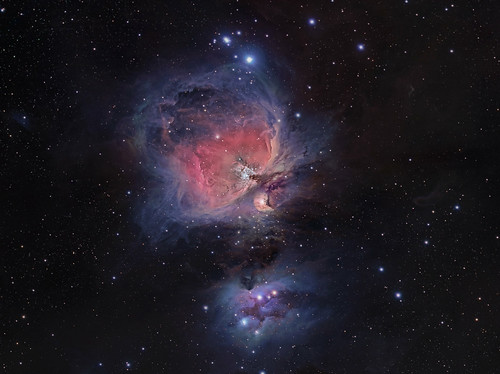 Orion Nebula by astrochuck, on Flickr
Orion Nebula by astrochuck, on Flickr
A 6 panel mosaic was used for Luminance (60x1min) Taken with a 11" Celestron EdgeHD with Hyperstar(F/2). and a QHY23M (60 min)
RGB was taken last year with a Astro-Tech AT65EDQ and a QHY9M(Red-5x600s
Green-5x600s Blue-5x600s) (2.5 hours)
The "core" of the nebula was emphasized with 6x60s Luminance filtered images taken with the EdgeHD @F/10. (6 min)
 Orion Nebula by astrochuck, on Flickr
Orion Nebula by astrochuck, on FlickrA 6 panel mosaic was used for Luminance (60x1min) Taken with a 11" Celestron EdgeHD with Hyperstar(F/2). and a QHY23M (60 min)
RGB was taken last year with a Astro-Tech AT65EDQ and a QHY9M(Red-5x600s
Green-5x600s Blue-5x600s) (2.5 hours)
The "core" of the nebula was emphasized with 6x60s Luminance filtered images taken with the EdgeHD @F/10. (6 min)
Re: Submissions: 2015 January
Another Orion complex series 
Taken with a Canon 6D (not modded) and an EF 200mm ƒ2.8 lens, giving the telescope guys a run for their money?
140x 30 seconds + 10 x 5 seconds, no darks or any other frames
ƒ3.2
6400 ISO
Stacked in Nebulosity, stretched in PS and LR.
Full stacked image:
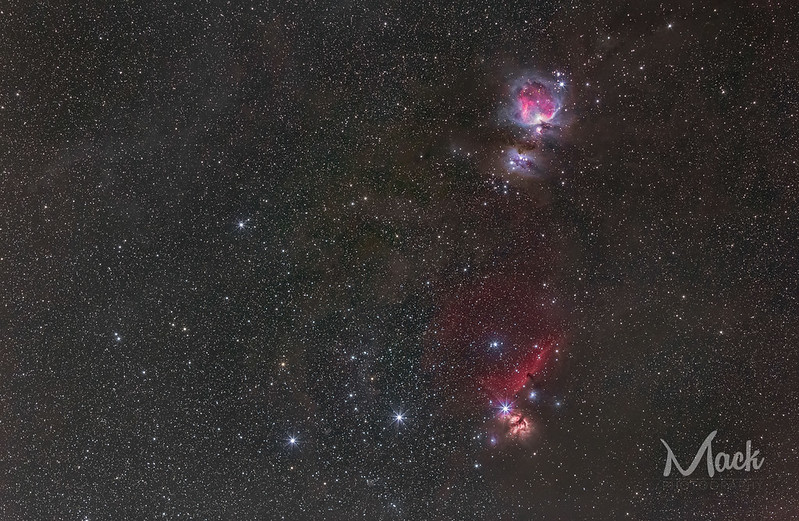 Pot full of Nebulas (re edit) by Mikey Mack, on Flickr
Pot full of Nebulas (re edit) by Mikey Mack, on Flickr
100% crops:
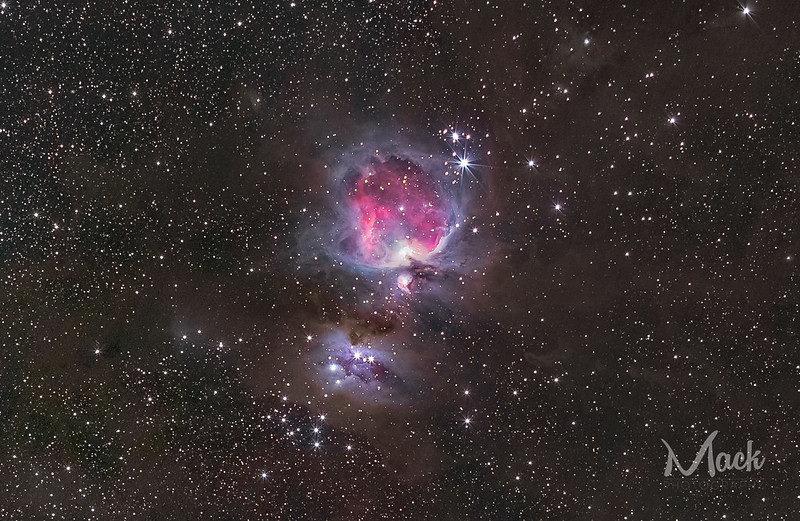 Orion Nebula (re edit) by Mikey Mack, on Flickr
Orion Nebula (re edit) by Mikey Mack, on Flickr
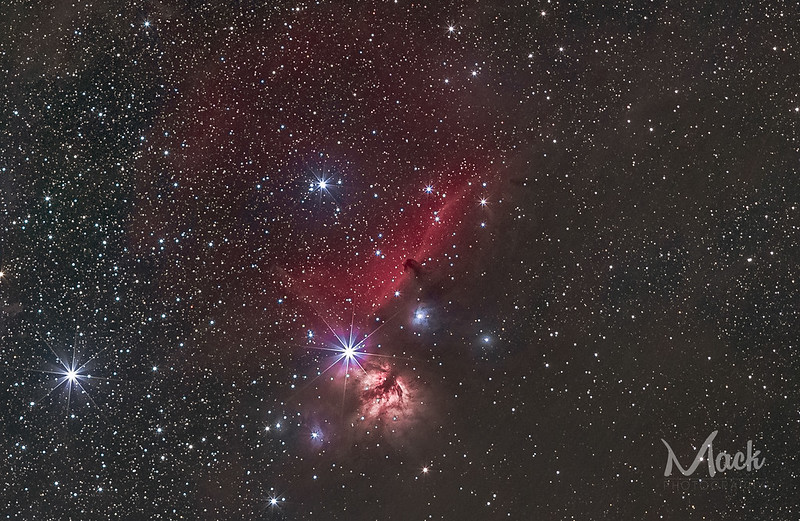 Flaming Horsehead! (re edit) by Mikey Mack, on Flickr
Flaming Horsehead! (re edit) by Mikey Mack, on Flickr
Taken with a Canon 6D (not modded) and an EF 200mm ƒ2.8 lens, giving the telescope guys a run for their money?
140x 30 seconds + 10 x 5 seconds, no darks or any other frames
ƒ3.2
6400 ISO
Stacked in Nebulosity, stretched in PS and LR.
Full stacked image:
 Pot full of Nebulas (re edit) by Mikey Mack, on Flickr
Pot full of Nebulas (re edit) by Mikey Mack, on Flickr100% crops:
 Orion Nebula (re edit) by Mikey Mack, on Flickr
Orion Nebula (re edit) by Mikey Mack, on Flickr Flaming Horsehead! (re edit) by Mikey Mack, on Flickr
Flaming Horsehead! (re edit) by Mikey Mack, on Flickr-
rcolombari
- Ensign
- Posts: 43
- Joined: Fri May 24, 2013 11:56 am
Eta Carinae
This image has been composed using frames from my Takahashi FS60c (SBIG8300):
L: 19x420s
Ha: 15x900s
RGB: (7, 7, 7)x420s
Belo Horizonte (southern side of the city), MG, Brazil
enhanced, in the eta carinae surroundings, with frames done with a 11" Rowe Ackermann astrograph at F2.2 by Cristóvão Jacques:
L: 25x30s
Oliveira, MG, Brazil
http://www.astrobin.com/152259/
L: 19x420s
Ha: 15x900s
RGB: (7, 7, 7)x420s
Belo Horizonte (southern side of the city), MG, Brazil
enhanced, in the eta carinae surroundings, with frames done with a 11" Rowe Ackermann astrograph at F2.2 by Cristóvão Jacques:
L: 25x30s
Oliveira, MG, Brazil
http://www.astrobin.com/152259/
Re: Submissions: 2015 January
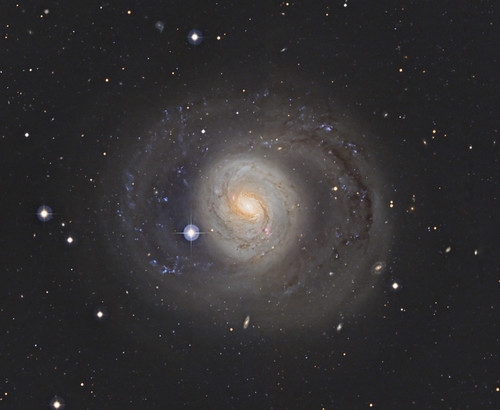
M77 Canadian-French-Hawaii Telescope/Hubble Space Telescope by Andre vd Hoeven, on Flickr
Recently I started working on crawling through some science databases of several large telescopes to see what data can be found in these archives. Some of the most interesting archives I found are, amongst others, the Subaru Telescope, the Gemini Telescopes, the Canadian-French-Hawaii-Telescope (CFHT) and of course the Hubble Legacy Archive.
This image shows a mosaic of Messier 77 made from data of two of these databases.
The widefield data was observed by the CFHT in visible light using Sloan u,g,r-filters, which is comparable to standard rgb. This image has a resolution of 0.28”/pixel, and is as far as I have found one of the most detailed images of this galaxies available.
The central part of this galaxy was observed by the Hubble Space Telescope and I used the data I generated for my price winning image of M77, which received a second place in the Hubble Hidden Treasures competition in 2012.
The data from the CFHT is really a great place to start. This 3,5 m / f 3.9 telescope has a huge ccd, comprised of 36 separate sensors, covering a field of 1x1 degree with a resolution of 0.18”/pixel. The total image is size is a mesmerising 340 Megapixels.
I downloaded the subimages of 2 ccd sensors covering M77 for this image in the mentioned filters and created an rgb image from this. The process of this I will describe in further detail during my workshop at the CEDIC conference in March in Austria and will be public after that.
Messier 77 / NGC 1068
Messier 77 was discovered by Pierre Méchain in 1780. Méchain communicated his discovery to Charles Messier, who listed the object in his famous catalog. Messier gave the following description: “A cluster of small stars which contains some nebulosity in the Whale and on the parallel of the star delta, reported of the 3rd mag. but which Messier estimates to be of the 5th. M. Mechain saw this cluster on the 29th Oct. 1780, in the form of a nebula.”
In 1848, Lord Rosse described the galaxy as having a spiral structure together with 14 other nebulae of spiral nature, which we now know to be galaxies.
Now it is known that M77 is a spiral galaxy at a distance of about 50 million light-years with a diameter of about 170.000 lightyears. At first sight, M77 looks like every an ordinary galaxy. However when examined closely some oddities appear. The core is much brighter than its direct surroundings. Spectral analysis reveals huge amounts of glowing gas present in the core, triggered by the presence of a black hole in the centre of the galaxy. The black hole is highly active and gaining mass by swallowing materials from the galaxy core. The cores of these types of galaxies are called AGN (Active Galactive Nuclei).
The galaxy belongs to the class of Seyfert galaxies that show clearly different spectral emission than ordinary galaxies, caused by the presence of huge amounts of gas not belonging to stars in the core.
Observations over a five day timespan with the Chandra X-ray observatory showed matter is being accelerated away from the core by the violent processes going on there. Over distances of up to 3000 light-years, material is ejected with speeds up to 2.5 million km/h, actively suppressing star formation near the core.
M77 is the largest member of a small group of galaxies which includes spiral galaxies NGC 1055 and NGC 1073 as well as five small, irregular galaxies located in the constellation of Cetus.
Image information:
Center (RA, Dec):(40.669, -0.012)
Center (RA, hms):02h 42m 40.553s
Center (Dec, dms):-00° 00' 44.902"
Size:11.5 x 9.41 arcmin
Radius:0.124 deg
Pixel scale:0.282 arcsec/pixel
Orientation:Up is 180 degrees E of N
Exposures:
CFHT:
5 x 40s g,r (green and red)
5 x 150s u (blue)
Hubble:
606, 658 and 814 nm data
Acknowledgements:
This data was generated using the facilities of the Canadian Astronomy Data Centre operated by the National Research Council of Canada with the support of the Canadian Space Agency.
Based on observations made with the NASA/ESA Hubble Space Telescope, and obtained from the Hubble Legacy Archive, which is a collaboration between the Space Telescope Science Institute (STScI/NASA), the Space Telescope European Coordinating Facility (ST-ECF/ESA) and the Canadian Astronomy Data Centre (CADC/NRC/CSA).
-
Klacsány Imre
- Asternaut
- Posts: 7
- Joined: Thu Sep 20, 2012 12:00 pm
- Location: Hungary
- Contact:
NGC 6826 Blinking planetary nebula
September 2014
Location: San Romualdo - Ravenna (Italy)
LX200 12"GPS with Starizona reducer/coma corrector F/7.1
CCD QSI 520wsi cooled -18
Baader RGB and Narrowband Filters
Autoguide with Magzero MZ5-M and PHDguiding on ETX105
HA-OIII-RGB: H-alpha Baader 7nm 38x5', OIII Baader 8,5nm 58x5', R 37x3', G 40x3', B 35x3'
Acquired with: MaximDL5 - Dark, Bias and Flat calibrated
Processed with: MaximDL5, Astroart4, StarTools1.3 and Paint Shop ProX7
Best regards,
Cristina Cellini
Location: San Romualdo - Ravenna (Italy)
LX200 12"GPS with Starizona reducer/coma corrector F/7.1
CCD QSI 520wsi cooled -18
Baader RGB and Narrowband Filters
Autoguide with Magzero MZ5-M and PHDguiding on ETX105
HA-OIII-RGB: H-alpha Baader 7nm 38x5', OIII Baader 8,5nm 58x5', R 37x3', G 40x3', B 35x3'
Acquired with: MaximDL5 - Dark, Bias and Flat calibrated
Processed with: MaximDL5, Astroart4, StarTools1.3 and Paint Shop ProX7
Best regards,
Cristina Cellini
-
francescodib
- Ensign
- Posts: 33
- Joined: Fri May 03, 2013 9:03 am
- Location: Trinitapoli - 76015 - Italy
Re: Submissions: 2015 January
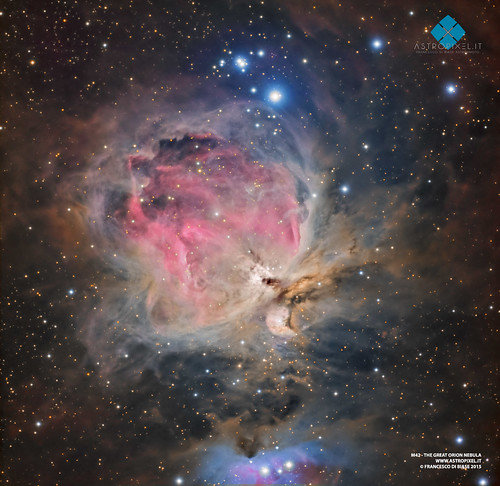 M42 The Great Orion Nebula HDR by Francescodb, on Flickr
M42 The Great Orion Nebula HDR by Francescodb, on FlickrCopyright: Francesco di Biase
http://www.astropixel.it





